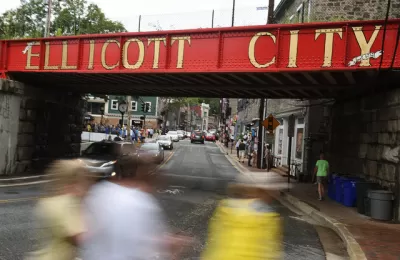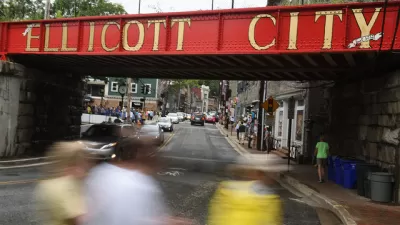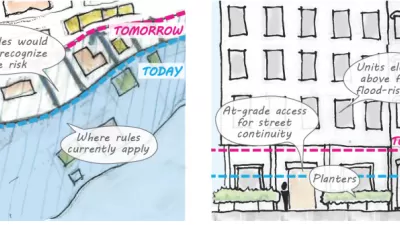Ellicott City, Maryland, a suburb located 12-miles from Baltimore with a historic Main Street that has experienced catastrophic flooding twice since 2016, offers a case study of the complementary effects of sprawl and climate change.

Two national feature stories explore the sage of Ellicott City, a Maryland suburb that has on several occasions been made into a poster child for the need to prepare for climate change, extreme weather, and the failures of past planning.
Rebecca Hersher and Ryan Kellman report for an interactive feature, published by NPR, with testimonials, maps, and harrowing videos of stormwaters repeatedly flooding down the city's historic Main Street, destroying property and taking lives.
After floods in 2016 and 2018, county officials decided to create a new stormwater plan that would require removing ten buildings on Main Street to make room for floodwaters.
"The original plan, calling for 10 buildings to be removed, would reduce the water level to about 5 feet if a similar flood happened again," according to the article. Eight feet of water had flooded Main Street in 2016.
The idea brought serious blowback on social media and in the town, and the city went back to the drawing board.
"On May 13, 2019, the county announced the final flood plan for Old Ellicott City. It will spend at least $113 million to tear down four buildings on lower Main Street and bore one tunnel," report Hesher and Kellman.
In a separate article by Amy Plitt, published by Curbed, the story focuses a little more on the flooding as a consequence of sprawl and climate change.
First, there's the effect of sprawl in the mix of factors that created the terrible scenes on Main Street in Ellicott City in 2016 and again in 2018:
The historic center of Ellicott City was clobbered, in part, because of the suburban developments that sprung up around the town after 1960. Farmland and forests were replaced with housing, driveways, and big-box shopping centers with hundreds of parking spaces, creating geographical conditions that exacerbate the impacts of weather events like severe storms. That suburban sprawl is, on a larger scale, contributing to climate change—and there are some who think Ellicott City needs to do more to curb it.
Then there's a fact that is also true of many other cities in the United States: there's just more rain.
According to the National Climate Assessment, 'heavy rainfall events have increased' in the Northeast—which the assessment defines as the area spanning from Maryland to Maine—more than in any other region in the country. "The amount of rain that falls during these events increased by 70 percent between 1958 and 2010."
FULL STORY: After the Water

Maui's Vacation Rental Debate Turns Ugly
Verbal attacks, misinformation campaigns and fistfights plague a high-stakes debate to convert thousands of vacation rentals into long-term housing.

Planetizen Federal Action Tracker
A weekly monitor of how Trump’s orders and actions are impacting planners and planning in America.

In Urban Planning, AI Prompting Could be the New Design Thinking
Creativity has long been key to great urban design. What if we see AI as our new creative partner?

Chicago’s Ghost Rails
Just beneath the surface of the modern city lie the remnants of its expansive early 20th-century streetcar system.

Baker Creek Pavilion: Blending Nature and Architecture in Knoxville
Knoxville’s urban wilderness planning initiative unveils the "Baker Creek Pavilion" to increase the city's access to green spaces.

Pedestrian Deaths Drop, Remain Twice as High as in 2009
Fatalities declined by 4 percent in 2024, but the U.S. is still nowhere close to ‘Vision Zero.’
Urban Design for Planners 1: Software Tools
This six-course series explores essential urban design concepts using open source software and equips planners with the tools they need to participate fully in the urban design process.
Planning for Universal Design
Learn the tools for implementing Universal Design in planning regulations.
planning NEXT
Appalachian Highlands Housing Partners
Mpact (founded as Rail~Volution)
City of Camden Redevelopment Agency
City of Astoria
City of Portland
City of Laramie





























